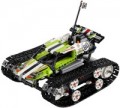Age
Age recommendations are quite conditional, but it is still not recommended to deviate from them. So construction toys for older children may contain small parts that a curious little child might swallow. At the same time, sets for little ones are easy to assemble and uninteresting for adult children. And an age-inappropriate construction set may turn out to be too complex and inconvenient, upsetting or even frightening the baby.
Note that the age category to some extent characterizes the maximum age at which the designer can be useful. For example, a set for
1+ and
2+ is unlikely to attract
an 8-year-old or even a
7-year-old primary school student, while a complex design
for 14+,
16+ and even
18+ often turns out to be interesting even for adults over 30 and even over 40. However, even within the same age category, much depends on the characteristics of a particular set, in particular, on the type of game. And there are design options for any age. In addition to those listed above, there are also
3+,
4+,
5+,
6+,
9+,
10+,
11+,
12+.
Number of pieces
The total number of parts included in the delivery of the designer. At the same time, the calculation, usually, also takes into account the details that make up individual characters (torso, arms, legs, head, etc.) — despite the fact that the figures are most often delivered assembled and are not designed for disassembly during normal use . Also note that the kit may include several spare parts, in case of breakage or loss of any of the main elements.
Models in assembly
The number of models that can be assembled from this kit according to the instructions. For example, if a helicopter, truck or boat can be assembled from a set, 3 models will be indicated in this paragraph. Most modern designers are designed for just
one model, quite often there are sets of
2 – 3 and
4 – 10 options, and in the most extensive sets this number can be
10 or more. Of course, a young inventor may not be limited to instructions and come up with his own assembly options; however, the most perfect and functional are usually the models that were originally provided for by the instructions.
Note that kits that allow multiple assembly options usually do not allow you to assemble more than one model at a time — that is, you can assemble a new model only by disassembling the previous one. However, there are exceptions to this rule — mainly among extensive sets of 5 or more options.
Moving elements (mechanics)
Details and elements that, after assembling the designer, can move, but are not driven by a motor; in other words, moving parts that need to be moved manually. These can be, for example, windows and doors, hatches, screws, crane booms, etc. The exception is rotating wheels — in this case they are not considered moving elements.
Mechanical moving elements can be combined with motorized ones (see below).
Remote control
The presence
of a remote control in the delivery set of the designer. This remote control can be either wired or wireless. It is found only in sets equipped with moving elements with a motor (see above), however, not every such set is equipped with a remote control, so the presence of this function should be specified separately. Also note that sets that are compatible with the remote control, but not equipped with it, do not belong to this category.

